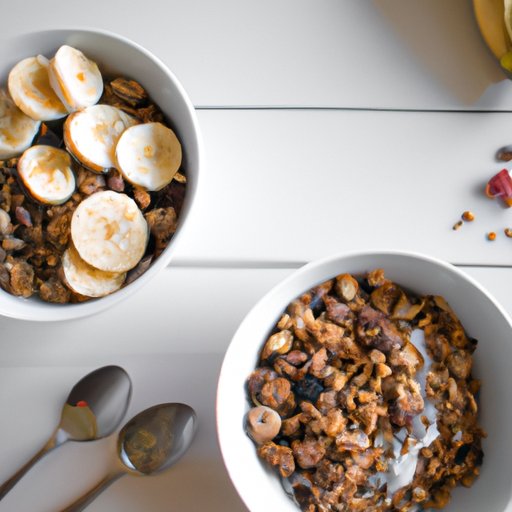Introduction
Granola is a popular snack that has been around for decades. It’s often eaten as a cereal with milk or yogurt, added to smoothies and shakes, used as a topping for desserts, or eaten on its own as a snack. But what makes granola so popular, and is it actually healthy? In this article, we’ll explore the benefits and risks of eating granola in order to determine whether it’s truly a healthy snack.
Exploring the Benefits and Risks of Eating Granola
Granola can vary greatly in terms of nutritional content, depending on the ingredients used. Generally speaking, it contains oats, nuts, seeds, sweeteners (such as honey or maple syrup), and sometimes dried fruit. It may also contain added vitamins and minerals, depending on the brand.
One of the primary benefits of eating granola is that it’s a source of complex carbohydrates, which provide energy for the body and help keep you feeling full for longer. It also contains fiber, which helps promote digestive health. Additionally, granola is usually high in protein and healthy fats, making it a great option for those looking to increase their intake of these important nutrients.
As for potential health risks, one concern is that some brands of granola can be high in sugar and calories. It’s important to read labels carefully to ensure that you’re getting a product that isn’t overly processed, and that doesn’t contain a lot of added sugar or artificial ingredients. Additionally, many brands of granola are baked with oil, which can add extra calories and fat. Finally, some types of granola may contain gluten, so it’s important to check the label if you have an intolerance or sensitivity to gluten.
A Nutritionist’s Take on the Health Benefits of Granola
“Granola can definitely be a healthy snack,” says registered dietitian and nutrition expert, Sarah Krieger. “The key is to watch your portion size and choose a product that isn’t overly processed or loaded with added sugar.” She suggests looking for products that contain whole grains, such as oats, and that are made with real ingredients like nuts, seeds, and dried fruit.
Krieger also recommends adding fresh fruit, such as berries or chopped apples, to boost the nutritional content of your granola snack. And she suggests opting for unsweetened nut milks or plain yogurt instead of cow’s milk or sweetened yogurt, which can add extra sugar and calories.
Are Granola Bars a Healthy Snack Option?
Granola bars are a convenient snack option, but they can vary greatly in terms of nutritional content. Some brands contain added sugars, artificial flavors, and preservatives, while others offer more natural options with fewer added ingredients. When choosing a granola bar, look for one that contains whole grains, nuts, and seeds, and that isn’t overly processed or high in added sugars.
It’s also important to compare the nutritional values of different brands. For example, some granola bars may be higher in fat and calories, while others may be lower in sugar and carbohydrates. Be sure to read the labels carefully and choose a product that fits your dietary needs and preferences.
Is Granola Really as Healthy as It Claims to Be?
When it comes to assessing the health benefits of granola, it’s important to consider the ingredients used. Different types of granola can vary greatly in terms of nutritional content, so it’s important to read labels carefully and choose a product that is made with whole grains, nuts, and seeds, and that doesn’t contain a lot of added sugar or artificial ingredients.
It’s also helpful to compare the nutritional values of different types of granola. For example, some products may be higher in fat and calories, while others may be lower in sugar and carbohydrates. Additionally, some granola products may be made with unhealthy oils, such as palm oil, which can add extra calories and fat. So it’s important to read labels carefully and choose a product that fits your dietary needs and preferences.

The Pros and Cons of Eating Granola for Breakfast
Granola can make a nutritious and delicious breakfast option, but there are a few things to consider. On the plus side, granola is a good source of complex carbohydrates and fiber, both of which are important for sustained energy throughout the day. Additionally, it’s usually high in protein and healthy fats, which can help keep you feeling fuller for longer.
On the other hand, some types of granola can be high in sugar and calories, so it’s important to read labels carefully and choose a product that isn’t overly processed or loaded with added sugar. Additionally, if you’re watching your weight, it’s important to monitor your portion size so you don’t overdo it. A single serving of granola should be about ¼ cup.
Conclusion
Granola can be a nutritious snack, but it’s important to consider the ingredients used and the nutritional content of different types of granola. In general, opt for products that contain whole grains, nuts, and seeds, and that aren’t overly processed or high in added sugars. Additionally, it’s important to monitor your portion size and watch out for products that are high in calories or fat. With these tips in mind, you can enjoy granola as part of a healthy and balanced diet.
(Note: Is this article not meeting your expectations? Do you have knowledge or insights to share? Unlock new opportunities and expand your reach by joining our authors team. Click Registration to join us and share your expertise with our readers.)
